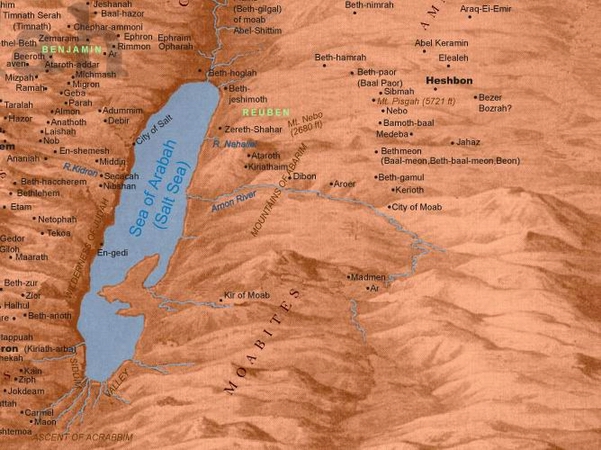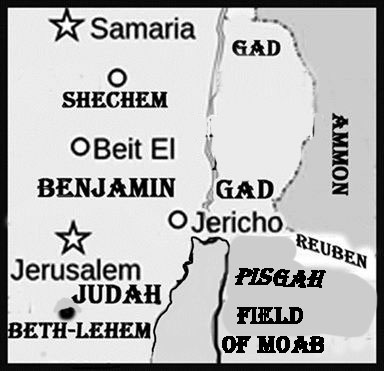Field of Moab (3 February 2016, 24 Shevet, 5776)
Continued from Field of Moab, and Field of Moab. Recap
Contents:
1. Introduction
2. James Rodriguez and Wikipedia
3. James Rodriguez and the Moabites
4. Brit-Am Answers to James Rodriguez: Where was the Field of Moab?
5. Brit-Am Answers to James Rodriguez: More Biblical Evidence
6. Brit-Am Answers to James Rodriguez: Why go to Moab? Parallels with the Jews and Germany Today

Map Source:
http://www.bible-history.com/geography/ancient-israel/israel-old-testament.html
1. Introduction
Yair Davidiy defends the otherwise-universally accepted belief that Ruth was a native Moabitess and of non-Israelite origin.
Ruth is described as coming from the Field of Moab (Ruth 1:1,2,6). Yair says this was the area out of the Arnon River (east of the Dead Sea) where Moabites dwelt in the time of the Judges.
James Rodriguez says that the expression Field of Moab means a region north of the Arnon River. This area was populated by the Israelite Tribe of Reuben. It had once belonged to Moab but first the Amorites, then the Israelties had conquered it. It was however, Rodriguez says, still known as Moab. Rodriguez says that when the Bible calls Ruth a Moabite woman (Ruth 1:3) it means she lived in this area and not that she really was a Moabitess.
In the article below James Rodriguez quotes the arguments of Yair from previous articles and counters them and is in turn answered by Yair.
2. James Rodriguez and Wikipedia
JR says:
The Wikipedia article (quoted by Yair in defence of his identification of the Field of Moab with the area south of the Arnon River) states:
"The territory occupied by Moab at the period of its greatest extent, before the invasion of the Amorites, divided itself naturally into three distinct and independent portions: The enclosed corner or canton south of the Arnon (referred to as "field of Moab");[18]
That is incorrect. The field or "sadeh" of Moab was located north, not south, of the Arnon and was given to the tribe of Reuben:
Num 21:20 And from Bamoth in the valley, that is in the country [sadeh] H7704 of Moab,H4124 to the top of Pisgah, which looketh toward Jeshimon (KJV).
Jos 13:15-17 And Moses had given to the tribe of the children of Reuben an inheritance according to their families. 16 Their territory was from Aroer, which is on the bank of the River Arnon, and the city that is in the midst of the ravine, and all the plain by Medeba; 17 Heshbon and all its cities that are in the plain: Dibon, Bamoth Baal, Beth Baal Meon,
Rth 1:1Â Now it came to pass in the days when the judges ruled,that there was a famine in the land. And a certain man of Bethlehemjudah went to sojourn in the country [sadeh] H7704 of Moab,H4124 he, and his wife, and his two sons (KJV).
According to Num 21:20, Bamoth (aka Bamoth Baal) is located in the "sadeh" of Moab, north of the Arnon in Reuben's territory (see map below), not the goy of Moab's territory, south of the Arnon, as the article claims.
3. James Rodriguez and the Moabites
JR says:
Also notice how all of the cities mentioned in Num 21 and Jos 13 above are located north of the Arnon. Leaving no doubt, Elimelech took his family to the "sadeh" of Moab in his brother Reuben's territory.
Consider how much more logical it would have been for Elimelech and his Judean family to have sojourned into his 'brothers' territory to escape a famine. Historically, Moab's descendants were a determined enemy of Israel. The Moabites, not too long before Ruth's time, refused to provide food and water to the Israelites. Do you really think they would allow them to dwell in their land to escape a famine?
'
Furthermore, why would any Israelite, in their right mind, journey to the land of their arch-enemy to escape a famine; live there ten years; intermarry with them; return to Israel with a daughter from the enemy and have a law-observing Israelite (Boaz) marry her with the elders uncontested blessing and hail her as the equal of Rachel and Leah (Rth 4:11)??'
Add to this the reminder of God's punishment of Israel, in the relatively recent past, for their idolatrous behavior with Moabites and Midianites, resulting in the impaling of Israelites and a plague causing 23,000 deaths (Num 25); along with the clear prohibition in Deu 23:3,  would have been a most potent deterrent for Israelites to stay as far away as possible from these people.Â
4. Brit-Am Answers to James Rodriguez: Where was the Field of Moab?
BR says:
JR says that the Field of Moab was to the north of the Arnon River, not to the south of it.
The only proof he brings for this claim is Numbers 21:20.
Num 21:20 And from Bamoth in the valley, that is in the country [sadeh] H7704 of Moab,H4124 to the top of Pisgah, which looketh toward Jeshimon (KJV).
[JR also mentions Bamoth BUT this is not necessarily the same as Bamoth Baal and were these two palces actuallyw ere is not known today. What JR wished to prove by his mentions of these locations is not clear.]
Let us look at this verse (NUmbers 21:20) in its context:
Numbers 21:
13 From there they journeyed and camped on the other side of the Arnon, which is in the wilderness that comes out of the border of the Amorites, for the Arnon is the border of Moab, between Moab and the Amorites. 14 Therefore it is said in the Book of the Wars of the Lord,
Waheb in Suphah,
And the wadis of the Arnon,
15 And the slope of the wadis
That extends to the site of Ar,
And leans to the border of Moab.
16 From there they continued to Beer, that is the well where the Lord said to Moses, Assemble the people, that I may give them water.
17 Then Israel sang this song:
Spring up, O well! Sing to it!
18 The well, which the leaders sank,
Which the nobles of the people dug,
With the scepter and with their staffs.
And from the wilderness they continued to Mattanah, 19 and from Mattanah to Nahaliel, and from Nahaliel to Bamoth, 20 and from Bamoth to the valley that is in the FIELD of Moab, at the top of Pisgah which overlooks the wasteland.
We know that the last station the Israelites had come to was north of the Arnon (Numbers 21:13). They had come up from Egypt from the southwest. The Edomites had not let them pass through their land so they went around it (Numbers 21:4). So too they were forbidden to conquer the land of the Moabites and the Moabites would not let let them pass through their land. They must therefore have gone around Moab as well and then come to the area north of the Arnon. They conquered this land from Sihon King of the Amorites (Numbers 21:21-26). "The valley that is in the FIELD of Moab" (Numbers 21:20) probably meant the valley of the Arnon River which marked the border between the Field of Moab and the region to its north in the Israelites had conquered.
5. Brit-Am Answers to James Rodriguez: More Biblical Evidence
BR says:
Jephthah from Gilead of Manasseh and the leader of Israel against the Ammonites recalled how,
Judges 11:
... And they also sent to the king of Moab, but he would not consent. So Israel remained at Kadesh. 18 Then they went through the wilderness and around the land of Edom and the land of Moab, and came to the east side of the land of Moab, and they camped beyond the Arnon; but they did not enter the territory of Moab, for the Arnon was the border of Moab. 19 And Israel sent messengers to Sihon king of the Amorites, the king of Heshbon, and Israel said to him, 'Please let us pass through your land to our place.' 20 But Sihon did not trust Israel to pass through his territory; so Sihon gathered all his people and camped in Jahaz and fought with Israel. 21 The Lord, the God of Israel, gave Sihon and all his people into the hand of Israel, and they defeated them; so Israel possessed all the land of the Amorites, the inhabitants of that country.Â
6. Brit-Am Answers to James Rodriguez: Why go to Moab?
BR says:
JR described the Moabites as enemies of Israel. He asks if the "Field of Moab" really meant the actual Country of Moab why would Elimelech from Judah want to go there? JR asks, How could he let his sons marry Moabite women assuming they really were such?
By way of answer,
Israelites were not strangers to the Moabites. A state of antagonism did not exist all the time.
We find later that David also sent his father and mother to Moab for the sake of their safety (1-Samuel 22:3).Â
Archaeologists say that the Moabites spoke a Hebrew dialect. They were descendants of Lot the nephew of Abraham and therefore of the same stock as the israelites. There was a famine in Judah (Ruth 1:1).
We find parallels in our own time.
The Jews in Germany suffered a horrendous experience during the Holocaust.
Nevertheless after the war there were Jews who moved to Germany.
Some of them have married German women.
What is difficult to understand here?
Such is human nature.
There are approximately 150,000Â Jews in Germany today.

Â
